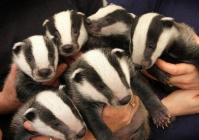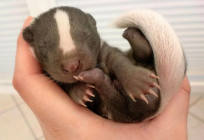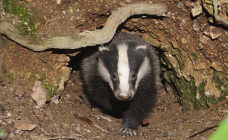Відмінності між версіями «Борсюк»
| Рядок 49: | Рядок 49: | ||
BADGER is a species of the class Mammalia of the Carnivora family in the Mustelidae family. It is well adapted to digging burrows in which it spends most of its life, so the badger's way of life is little known. | BADGER is a species of the class Mammalia of the Carnivora family in the Mustelidae family. It is well adapted to digging burrows in which it spends most of its life, so the badger's way of life is little known. | ||
| − | + | '''Description''' | |
European badgers are powerfully built animals with small heads, thick, short necks, stocky, wedge-shaped bodies and short tails. Their feet are plantigrade or semidigitigrade and short, with five toes on each foot. The limbs are short and massive, with naked lower surfaces on the feet. The claws are strong, elongated and have an obtuse end, which assists in digging. The claws are not retractable, and the hind claws wear with age. Old badgers sometimes have their hind claws almost completely worn away from constant use.Their snouts, which are used for digging and probing, are muscular and flexible. The eyes are small and the ears short and tipped with white. Whiskers are present on the snout and above the eyes. | European badgers are powerfully built animals with small heads, thick, short necks, stocky, wedge-shaped bodies and short tails. Their feet are plantigrade or semidigitigrade and short, with five toes on each foot. The limbs are short and massive, with naked lower surfaces on the feet. The claws are strong, elongated and have an obtuse end, which assists in digging. The claws are not retractable, and the hind claws wear with age. Old badgers sometimes have their hind claws almost completely worn away from constant use.Their snouts, which are used for digging and probing, are muscular and flexible. The eyes are small and the ears short and tipped with white. Whiskers are present on the snout and above the eyes. | ||
| − | + | '''Food''' | |
Earthworms are their most important food source, followed by large insects, carrion, cereals, fruit and small mammals, including rabbits, mice, shrews, moles and hedgehogs. Insect prey includes chafers, dung and ground beetles, caterpillars, leatherjackets, and the nests of wasps and bumblebees. They are able to destroy wasp nests, consuming the occupants, combs, and envelope, such as that of Vespula rufa nests, since their thick skin and body hair protect the badgers from stings.[63] Cereal food includes wheat, oats, maize and occasionally barley. Fruits include windfall apples, pears, plums, blackberries, bilberries, raspberries, strawberries, acorns, beechmast, pignuts and wild arum corms. | Earthworms are their most important food source, followed by large insects, carrion, cereals, fruit and small mammals, including rabbits, mice, shrews, moles and hedgehogs. Insect prey includes chafers, dung and ground beetles, caterpillars, leatherjackets, and the nests of wasps and bumblebees. They are able to destroy wasp nests, consuming the occupants, combs, and envelope, such as that of Vespula rufa nests, since their thick skin and body hair protect the badgers from stings.[63] Cereal food includes wheat, oats, maize and occasionally barley. Fruits include windfall apples, pears, plums, blackberries, bilberries, raspberries, strawberries, acorns, beechmast, pignuts and wild arum corms. | ||
| Рядок 58: | Рядок 58: | ||
Der Dachs ist ein Raubtier aus der Familie der Marder und eine von vier Arten der Gattung Meles. | Der Dachs ist ein Raubtier aus der Familie der Marder und eine von vier Arten der Gattung Meles. | ||
Der Dachs - räuberisches Waldpelztier aus der Familie der Marder. | Der Dachs - räuberisches Waldpelztier aus der Familie der Marder. | ||
| − | + | ||
| + | '''Essen''' | ||
| + | |||
Im Unterschied zu anderen Musteliden ist der Dachs kein ausgesprochener Fleischfresser und nutzt zeitweise das jahreszeitliche Angebot an pflanzlicher Kost fast ausschließlich. Die Hauptnahrung besteht jedoch aus Regenwürmern, die im Frühjahr bis zu 50 % der Nahrung ausmachen können. Wenn diese im Sommer und Herbst aufgrund der Trockenheit der Böden kaum verfügbar sind, werden verstärkt andere Nahrungsquellen genutzt. | Im Unterschied zu anderen Musteliden ist der Dachs kein ausgesprochener Fleischfresser und nutzt zeitweise das jahreszeitliche Angebot an pflanzlicher Kost fast ausschließlich. Die Hauptnahrung besteht jedoch aus Regenwürmern, die im Frühjahr bis zu 50 % der Nahrung ausmachen können. Wenn diese im Sommer und Herbst aufgrund der Trockenheit der Böden kaum verfügbar sind, werden verstärkt andere Nahrungsquellen genutzt. | ||
Версія за 20:21, 19 жовтня 2021
Борсюк, -ка, м. = Борсук. Вх. Пч. II. 6.
Зміст
Сучасні словники
Тлумачення слова у сучасних словниках БОРСЮК, -ка - хижий лісовий хутровий звір з родини куницевих.
БОРСЮК, -ка - вид класу Ссавці (Mammalia) ряду Хижі (Carnivora) родини Куницеві (Mustelidae).Він відмінно пристосований до риття нір, у яких проводить більшу частину життя, тому спосіб життя борсука маловідомий.
Розміри
Довжина: 75-98 см від мордочки до хвоста.
Висота в холці: 30 см.
Маса: самці в середньому 10-18 кг, самки 7-14 кг.
Спосіб життя
Борсук веде осілий спосіб життя. Оселяється в лісах усіх типів, у відкритих біотопах, там де є добрі захисні умови у вигляді чагарників. Для побудови поселень частіше обирає місця з ґрунтом, зручним для риття, та природними нерівностями рельєфу: яри, балки, круті береги водойм. Може жити поряд із людиною й навіть у містах. Борсуки живуть сім'ями. Число особин у сімейній групі залежить від того, яка є кількість їжі на даній території. Іноді околиці населяють декілька таких груп борсуків. Просторова організація популяцій борсуків залежить від особливостей розташування ділянок окремих сімейних груп. Кожна сімейна ділянка формується за рахунок діяльності всіх членів сімейної групи. В умовах низької чисельності тварини можуть вести самотній спосіб життя. Сімейство живе в одному підземному містечку. Главою сімейства є самець-ватажок, який відганяє чужих борсуків, коли ті підходять до нори занадто близько. Члени сімейства відрізняють один одного по запаху, який виділяється пахучими залозами. У пошуках їжі борсуки заходять дуже далеко, при цьому вони завжди користуються одними й тими ж самими стежками. Якщо на території є достатньо їжі, то радіус пошуку їжі борсуків становить близько двох кілометрів.
Харчування
Борсук майже всеїдний - він їсть також і дрібних ссавців: кроликів, кротів і пацюків, особливо їхніх дитинчат, а також комах, равликів і жаб. Різне коріння, рослини й фрукти теж є важливим доповненням його меню.У нього не дуже добрий зір, тому під час пошуків їжі він покладається в основному на свій чутливий нюх і чуткий слух.
Незважаючи на те, що борсук є досить сильною твариною, його улюблена їжа - це звичайні дощові черв'яки. Розшукуючи цих хробаків, у вологі осінні ночі він здійснює десятигодинні переходи. Борсук виходить із нори на полювання найчастіше тоді, коли наступає темрява.
Кормовий раціон борсука включає 52 види тварин і 47 видів рослин.Кількість тих чи інших кормів залежить не тільки від сезонну, але й від кліматичних особливостей року. Температура та кількість опадів особливо впливають на стан популяцій безхребетних (основних кормових об'єктів у багатьох частинах ареалу), отже й на популяції борсуків. Вища смертність серед тварин, як молодих, так і дорослих, спостерігається у сухі роки з високою середньою температурою.
Розмноження
Шлюбний період у борсуків триває з лютого по жовтень. Пік шлюбного періоду припадає на вересень. У цей час вони найчастіше паруються.Після запліднення у розвитку ембріона спостерігається довга стадія спокою — ембріональна діапауза.
Вагітність може становити від 270 днів (спарювання влітку) до 376 днів (спарювання наприкінці зими). На світ з'являється від 1 до 4 дитинчат. Пологи відбуваються в спеціально приготовленій для цього дитячій кімнаті. Тут дитинчата залишаються протягом восьми тижнів.
Після двох місяців виходять з матір'ю із нори в пошуках їжі, але годуватися молоком перестануть тільки в чотири місяці.До самостійного живлення молоді борсуки переходять, починаючи з віку 3—3,5 місяців. Статевої зрілості досягають на другий рік життя. Тривалість життя борсука може становити 15 років, але в середньому — 5—6 років.
Ілюстрації

|

|

|

|
Медіа
Іншими мовами
In English
BADGER is a predatory forest fur animal from the marten family.
BADGER is a species of the class Mammalia of the Carnivora family in the Mustelidae family. It is well adapted to digging burrows in which it spends most of its life, so the badger's way of life is little known. Description European badgers are powerfully built animals with small heads, thick, short necks, stocky, wedge-shaped bodies and short tails. Their feet are plantigrade or semidigitigrade and short, with five toes on each foot. The limbs are short and massive, with naked lower surfaces on the feet. The claws are strong, elongated and have an obtuse end, which assists in digging. The claws are not retractable, and the hind claws wear with age. Old badgers sometimes have their hind claws almost completely worn away from constant use.Their snouts, which are used for digging and probing, are muscular and flexible. The eyes are small and the ears short and tipped with white. Whiskers are present on the snout and above the eyes. Food Earthworms are their most important food source, followed by large insects, carrion, cereals, fruit and small mammals, including rabbits, mice, shrews, moles and hedgehogs. Insect prey includes chafers, dung and ground beetles, caterpillars, leatherjackets, and the nests of wasps and bumblebees. They are able to destroy wasp nests, consuming the occupants, combs, and envelope, such as that of Vespula rufa nests, since their thick skin and body hair protect the badgers from stings.[63] Cereal food includes wheat, oats, maize and occasionally barley. Fruits include windfall apples, pears, plums, blackberries, bilberries, raspberries, strawberries, acorns, beechmast, pignuts and wild arum corms.
Occasionally, they feed on medium to large birds, amphibians, small reptiles including tortoises, snails, slugs, fungi, and green food such as clover and grass, particularly in winter and during droughts. Badgers characteristically capture large numbers of one food type in each hunt. Generally, they do not eat more than 0.5 kg (1.1 lb) of food per day, with young specimens yet to attain one year of age eating more than adults. An adult badger weighing 15 kg (33 lb) eats a quantity of food equal to 3.4% of its body weight.
Auf Deutsch
Der Dachs ist ein Raubtier aus der Familie der Marder und eine von vier Arten der Gattung Meles. Der Dachs - räuberisches Waldpelztier aus der Familie der Marder.
Essen
Im Unterschied zu anderen Musteliden ist der Dachs kein ausgesprochener Fleischfresser und nutzt zeitweise das jahreszeitliche Angebot an pflanzlicher Kost fast ausschließlich. Die Hauptnahrung besteht jedoch aus Regenwürmern, die im Frühjahr bis zu 50 % der Nahrung ausmachen können. Wenn diese im Sommer und Herbst aufgrund der Trockenheit der Böden kaum verfügbar sind, werden verstärkt andere Nahrungsquellen genutzt.
Das übrige Nahrungsspektrum ist jedoch sehr breit. Neben Regenwürmern machen Insekten und bei diesen insbesondere die Imagines von Hautflüglern, Larven von Mai- und Mistkäfern, Nachtfaltern sowie Laufkäfer einen großen Anteil der tierischen Nahrung aus, aber auch Vertreter anderer Käfer- oder Insektengruppen zählen dazu. Weitere Wirbellose wie Schnecken oder Muscheln spielen eine untergeordnete Rolle. Bei den Kleinsäugern sind mit einem großen Anteil vor allem Wühlmäuse vertreten. Seltener gehören Spitzmäuse, Maulwürfe oder junge Wildkaninchen zur Beute.
Див. також
Джерела та література
http://www.zoolog.com.ua/ssavci27.html
Дикий І. Особливості поселень борсука (Meles meles L.) на території заходу України // Вісник Львівського університету, серія біологічна. — 2005. — В. 40. — С. 101–110.
Делеган І. В., Делеган І. І., Делеган І. І. Біологія лісових птахів і звірів / За ред. І. В. Делегана. — Львів: Поллі, 2005. — 600 с.